Long-Term Performance of Distributed Optical Fiber Sensors Embedded in Reinforced Concrete Beams under Sustained Deflection and Cyclic Loading
Abstract
:1. Introduction
2. Experimental Program
2.1. Geometry and Reinforcement Layout
2.2. Instrumentation
2.3. Test Setup and Loading Procedure
3. Results and Discussion
3.1. DOFS Measurements and Beam Behavior under Sustained Deflection
3.1.1. Load Evolution under Sustained Deflection
3.1.2. Evolution of Strain, Curvature and Crack Width in Cracked Sections
3.1.3. Evolution of Curvature Distribution and Maximum Deflection
3.2. DOFS Measurements and Beam Behavior under Cyclic Loading
3.2.1. Load History
3.2.2. Evolution of Strains and Crack Widths
3.2.3. Evolution and Validation of Beam Deflections
3.2.4. Validation of the Crack Width Calculation
4. Conclusions
- The high precision, accuracy, and stability of the DOFS enabled the detection of subtle changes in strain and deflections due to both short-time variations of the applied load regardless of the load magnitude and the cycle pulse duration, as well as long-term time-dependent effects such as creep. In particular, a curvature redistribution due to differential creep between the constant moment region and the shear spans was detected in beams subjected to sustain deflection.
- It has been shown that methods developed and tested in previous studies for the monitoring of deflections and crack widths under short-term loading can be also applied under long-term sustained and cyclic loading to measure the structural performance of RC elements over time.
- Using DIC as a reference, it was demonstrated that the values of deflection and crack widths calculated based on the measured DOFS strains remain accurate over time, regardless of the type of loading.
- None of the results seem to indicate a loss of performance of the fiber optic cable over time, either under sustained deflection (no relaxation due to high sustain load) or under cyclic loading (no bond degradation due to repeated loading). Therefore, the combination of Rayleigh scattering and the tested robust fiber optic cable have the potential to be used in real long-term applications without losing accuracy.
Author Contributions
Funding
Institutional Review Board Statement
Informed Consent Statement
Data Availability Statement
Conflicts of Interest
References
- Milnes, C.; Aellig, P.; Gaullier, N.; Schneider-Roos, K.; Huber, D.; Wiener, D.; Guldimann, R. Global Infrastructure Basel 4th GIB Summit Report; Global Infrastructure Basel (GIB) Foundation: Basel, Switzerland, 2014; Available online: https://gib-foundation.org/wp-content/uploads/2020/01/Summit-Report_ext_Fin_sml.pdf (accessed on 20 September 2021).
- Glišić, B.; Hubbell, D.; Sigurdardottir, D.H.; Yao, Y. Damage detection and characterization using long-gauge and distributed fiber optic sensors. Opt. Eng. 2013, 52, 087101. [Google Scholar] [CrossRef]
- Casas, J.; Cruz, P. Fiber Optic Sensors for Bridge Monitoring. J. Bridg. Eng. 2003, 8, 362–373. [Google Scholar] [CrossRef] [Green Version]
- Bao, Y.; Huang, Y.; Hoehler, M.S.; Chen, G. Review of Fiber Optic Sensors for Structural Fire Engineering. Sensors 2019, 19, 877. [Google Scholar] [CrossRef] [Green Version]
- Barrias, A.J.D.S.; Casas, J.R.; Villalba, S. A Review of Distributed Optical Fiber Sensors for Civil Engineering Applications. Sensors 2016, 16, 748. [Google Scholar] [CrossRef] [Green Version]
- Leal-Junior, A.G.; Díaz, C.R.; Marques, C.; Pontes, M.J.; Frizera, A. Multiplexing technique for quasi-distributed sensors arrays in polymer optical fiber intensity variation-based sensors. Opt. Laser Technol. 2018, 111, 81–88. [Google Scholar] [CrossRef]
- Güemes, A.; Fernández-López, A.; Soller, B. Optical Fiber Distributed Sensing-Physical Principles and Applications. Struct. Health Monit. 2010, 9, 233–245. [Google Scholar] [CrossRef]
- Rodriguez, G.; Casas, J.R.; Villalba, S. SHM by DOFS in civil engineering: A review. Struct. Monit. Maint. 2015, 2, 357–382. [Google Scholar] [CrossRef] [Green Version]
- Bao, Y.; Chen, G. Strain distribution and crack detection in thin unbonded concrete pavement overlays with fully distributed fiber optic sensors. Opt. Eng. 2015, 55, 011008. [Google Scholar] [CrossRef]
- Billon, A.; Hénault, J.-M.; Quiertant, M.; Taillade, F.; Khadour, A.; Martin, R.-P.; Benzarti, K. Qualification of a distributed optical fiber sensor bonded to the surface of a concrete structure: A methodology to obtain quantitative strain measurements. Smart Mater. Struct. 2015, 24, 115001. [Google Scholar] [CrossRef]
- Henault, J.-M.; Quiertant, M.; Delepine-Lesoille, S.; Salin, J.; Moreau, G.; Taillade, F.; Benzarti, K. Quantitative strain measurement and crack detection in RC structures using a truly distributed fiber optic sensing system. Constr. Build. Mater. 2012, 37, 916–923. [Google Scholar] [CrossRef]
- Tan, X.; Bao, Y. Measuring crack width using a distributed fiber optic sensor based on optical frequency domain reflectometry. Measurement 2020, 172, 108945. [Google Scholar] [CrossRef]
- Tan, X.; Abu-Obeidah, A.; Bao, Y.; Nassif, H.; Nasreddine, W. Measurement and visualization of strains and cracks in CFRP post-tensioned fiber reinforced concrete beams using distributed fiber optic sensors. Autom. Constr. 2021, 124, 103604. [Google Scholar] [CrossRef]
- Berrocal, C.G.; Fernandez, I.; Rempling, R. Crack monitoring in reinforced concrete beams by distributed optical fiber sensors. Struct. Infrastruct. Eng. 2020, 17, 124–139. [Google Scholar] [CrossRef] [Green Version]
- Rodríguez, G.; Casas, J.; Villaba, S. Cracking assessment in concrete structures by distributed optical fiber. Smart Mater. Struct. 2015, 24, 035005. [Google Scholar] [CrossRef] [Green Version]
- Rodriguez, G.; Casas, J.R.; Villalba, S. Shear crack width assessment in concrete structures by 2D distributed optical fiber. Eng. Struct. 2019, 195, 508–523. [Google Scholar] [CrossRef]
- Barrias, A.; Casas, J.R.; Villalba, S.; Barrias, A.; Casas, J.R.; Villalba, S. Embedded Distributed Optical Fiber Sensors in Reinforced Concrete Structures—A Case Study. Sensors 2018, 18, 980. [Google Scholar] [CrossRef] [PubMed] [Green Version]
- Barrias, A.; Casas, J.R.; Villalba, S. Distributed optical fibre sensors in concrete structures: Performance of bonding adhesives and influence of spatial resolution. Struct. Control Health Monit. 2018, 26, e2310. [Google Scholar] [CrossRef]
- Bado, M.F.; Casas, J.R.; Dey, A.; Gil Berrocal, C. Distributed Optical Fiber Sensing Bonding Techniques Performance for Embedment inside Reinforced Concrete Structures. Sensors 2020, 20, 5788. [Google Scholar] [CrossRef]
- Davis, M.B.; Hoult, N.A.; Bajaj, S.; Bentz, E.C. Distributed Sensing for Shrinkage and Tension Stiffening Measurement. ACI Struct. J. 2017, 114. [Google Scholar] [CrossRef] [Green Version]
- Brault, A.; Hoult, N. Distributed Reinforcement Strains: Measurement and Application. ACI Struct. J. 2019, 116. [Google Scholar] [CrossRef]
- Regier, R.; Hoult, N.A. Concrete deterioration detection using distributed sensors. Proc. Inst. Civ. Eng. Struct. Build. 2015, 168, 118–126. [Google Scholar] [CrossRef]
- Bassil, A.; Chapeleau, X.; LeDuc, D.; Abraham, O. Concrete Crack Monitoring Using a Novel Strain Transfer Model for Distributed Fiber Optics Sensors. Sensors 2020, 20, 2220. [Google Scholar] [CrossRef] [PubMed] [Green Version]
- Bassil, A. Distributed Fiber Optics Sensing for Crack Monitoring of Concrete Structures. Ph.D. Thesis, Université de Nantes, Nantes, France, 2019. Available online: https://hal.archives-ouvertes.fr/tel-02951164/document (accessed on 20 September 2021).
- Berrocal, C.G.; Fernandez, I.; Bado, M.F.; Casas, J.R.; Rempling, R. Assessment and visualization of performance indicators of reinforced concrete beams by distributed optical fibre sensing. Struct. Health Monit. 2021. [Google Scholar] [CrossRef]
- Brault, A.; Hoult, N. Monitoring Reinforced Concrete Serviceability Performance Using Fiber Optic Sensors. ACI Struct. J. 2019, 116. [Google Scholar] [CrossRef]
- Poldon, J.J.; Hoult, N.A.; Bentz, E.C. Distributed Sensing in Large Reinforced Concrete Shear Test. ACI Struct. J. 2019, 116, 235–245. [Google Scholar] [CrossRef]
- Barrias, A.; Rodriguez, G.; Casas, J.R.; Villalba, S. Application of distributed optical fiber sensors for the health monitoring of two real structures in Barcelona. Struct. Infrastruct. Eng. 2018, 14, 967–985. [Google Scholar] [CrossRef]
- Gómez, J.; Casas, J.R.; Villalba, S. Structural Health Monitoring with Distributed Optical Fiber Sensors of tunnel lining affected by nearby construction activity. Autom. Constr. 2020, 117, 103261. [Google Scholar] [CrossRef]
- Monsberger, C.M.; Lienhart, W. Distributed fiber optic shape sensing along shotcrete tunnel linings: Methodology, field applications, and monitoring results. J. Civ. Struct. Health Monit. 2021, 11, 337–350. [Google Scholar] [CrossRef]
- Monsberger, C.M.; Lienhart, W.; Hayden, M. Distributed fiber optic sensing along driven ductile piles: Design, sensor installation and monitoring benefits. J. Civ. Struct. Health Monit. 2020, 10, 627–637. [Google Scholar] [CrossRef]
- Bado, M.; Casas, J. A Review of Recent Distributed Optical Fiber Sensors Applications for Civil Engineering Structural Health Monitoring. Sensors 2021, 21, 1818. [Google Scholar] [CrossRef]
- Barrias, A.; Casas, J.; Villalba, S. Fatigue performance of distributed optical fiber sensors in reinforced concrete elements. Constr. Build. Mater. 2019, 218, 214–223. [Google Scholar] [CrossRef]
- Cantone, R.; Ruiz, M.F.; Muttoni, A. A detailed view on the rebar–to–concrete interaction based on refined measurement techniques. Eng. Struct. 2020, 226, 111332. [Google Scholar] [CrossRef]
- Broth, Z.; Hoult, N.A. Dynamic distributed strain sensing to assess reinforced concrete behaviour. Eng. Struct. 2019, 204, 110036. [Google Scholar] [CrossRef]
- Bado, M.F.; Casas, J.R.; Barrias, A. Performance of Rayleigh-Based Distributed Optical Fiber Sensors Bonded to Reinforcing Bars in Bending. Sensors 2018, 18, 3125. [Google Scholar] [CrossRef] [PubMed] [Green Version]
- Bado, M.F.; Casas, J.R.; Gómez, J. Post-processing algorithms for distributed optical fiber sensing in structural health monitoring applications. Struct. Health Monit. 2020, 20, 661–680. [Google Scholar] [CrossRef]
- EN 12390-3:2009. Testing Hardened Concrete. Part 3: Compressive Strength of Test Specimens; CEN: Brussels, Belgium, 2009. [Google Scholar]
- Bado, M.F.; Casas, J.R.; Dey, A.; Berrocal, C.G.; Kaklauskas, G.; Fernandez, I.; Rempling, R. Characterization of concrete shrinkage induced strains in internally-restrained RC structures by distributed optical fiber sensing. Cem. Concr. Compos. 2021, 120, 104058. [Google Scholar] [CrossRef]
- Tan, X.; Bao, Y.; Zhang, Q.; Nassif, H.; Chen, G. Strain transfer effect in distributed fiber optic sensors under an arbitrary field. Autom. Constr. 2021, 124, 103597. [Google Scholar] [CrossRef]
- Hordijk, D. Local Approach to Fatigue of Concrete. Ph.D. Thesis, Technische Universiteit Delft, Delft, The Netherlands, 1991. [Google Scholar]
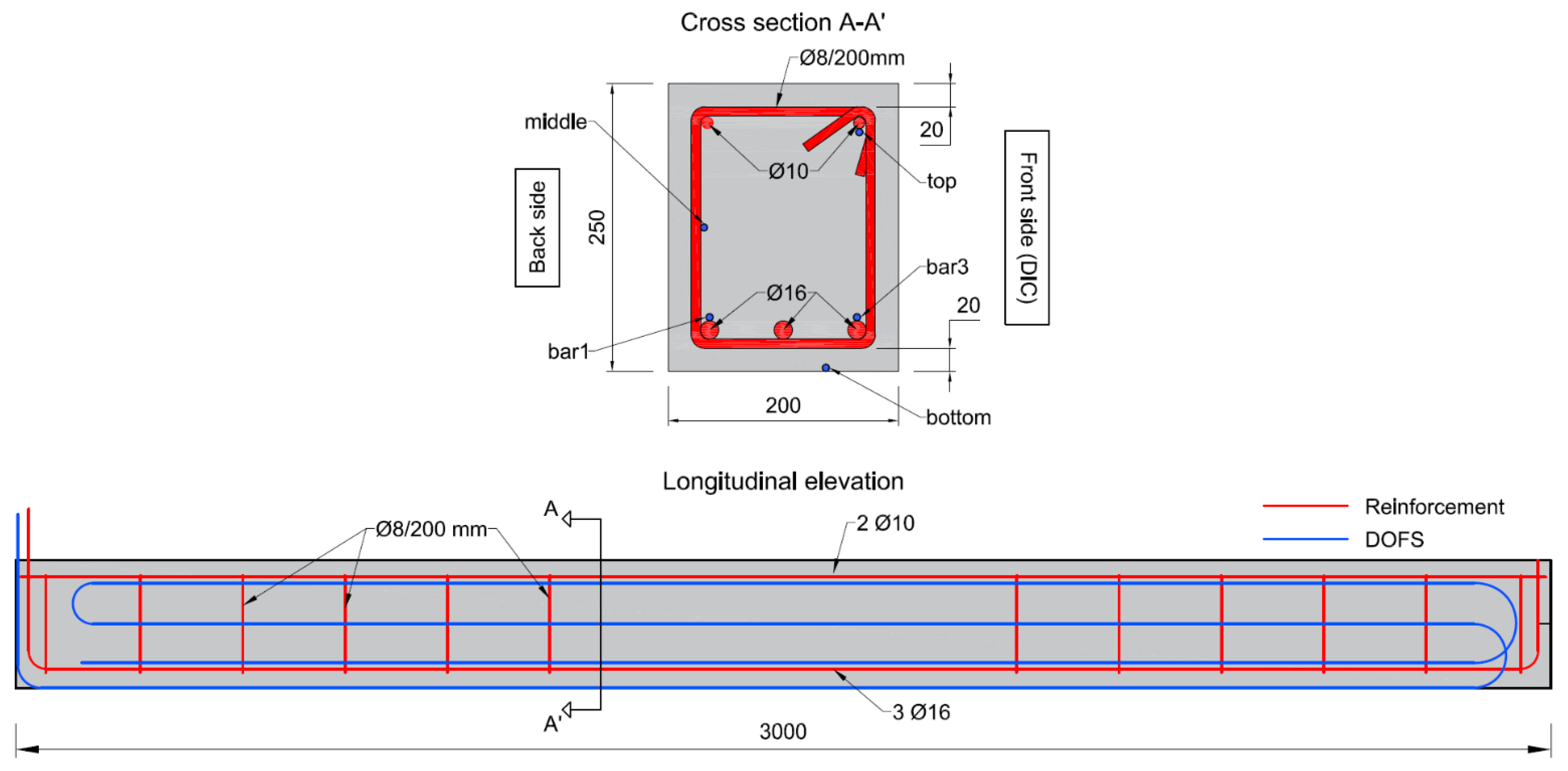
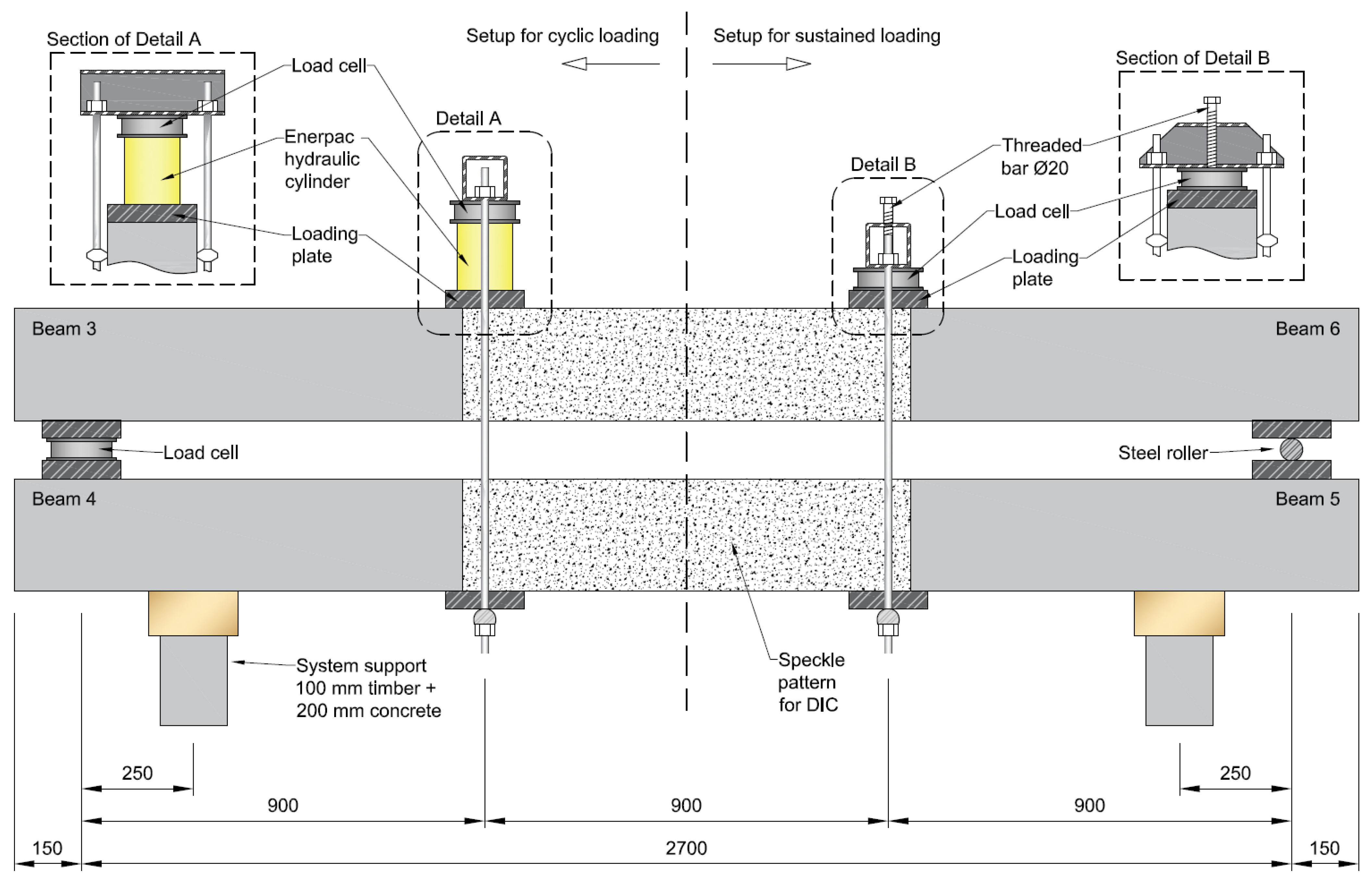
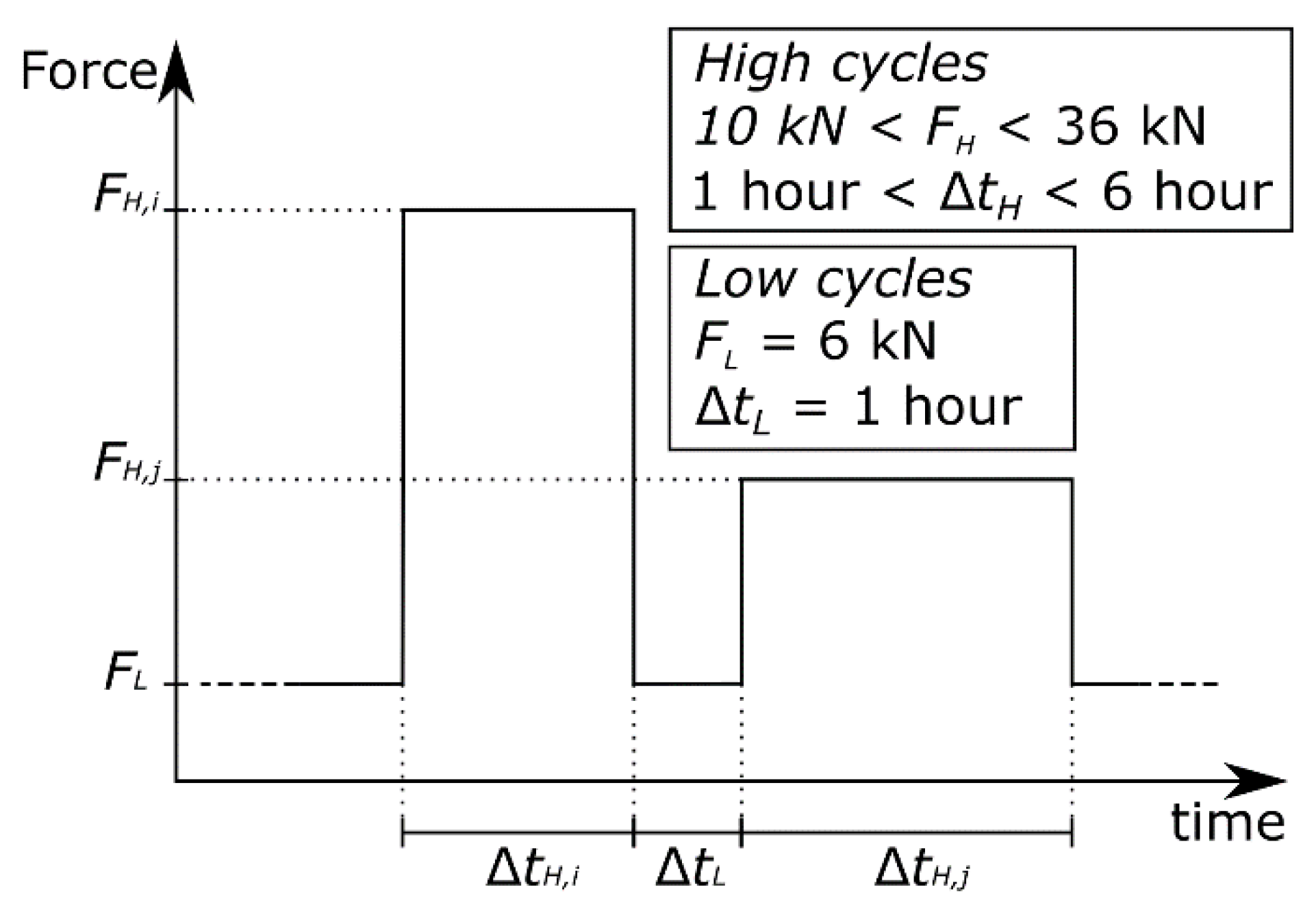
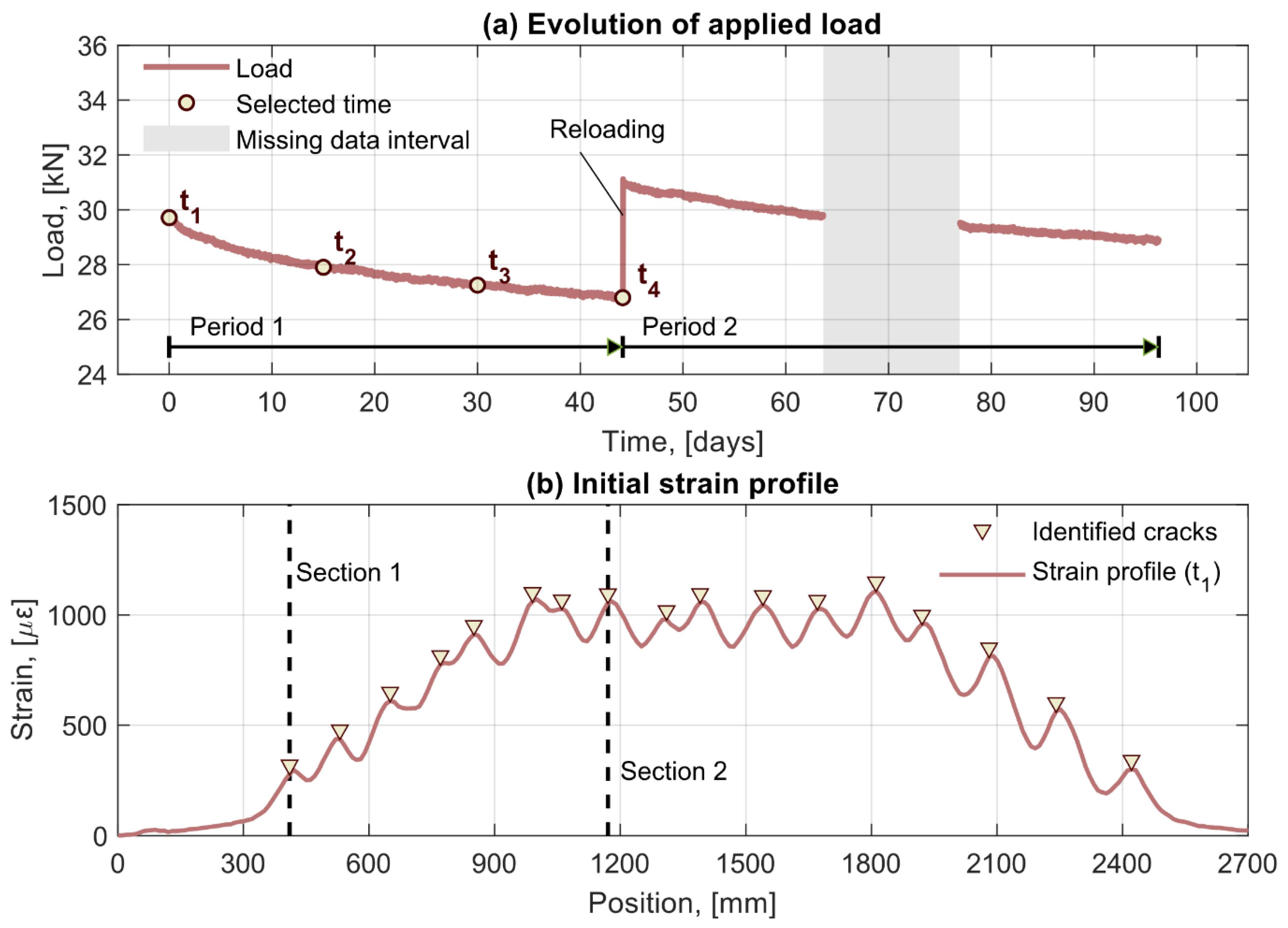
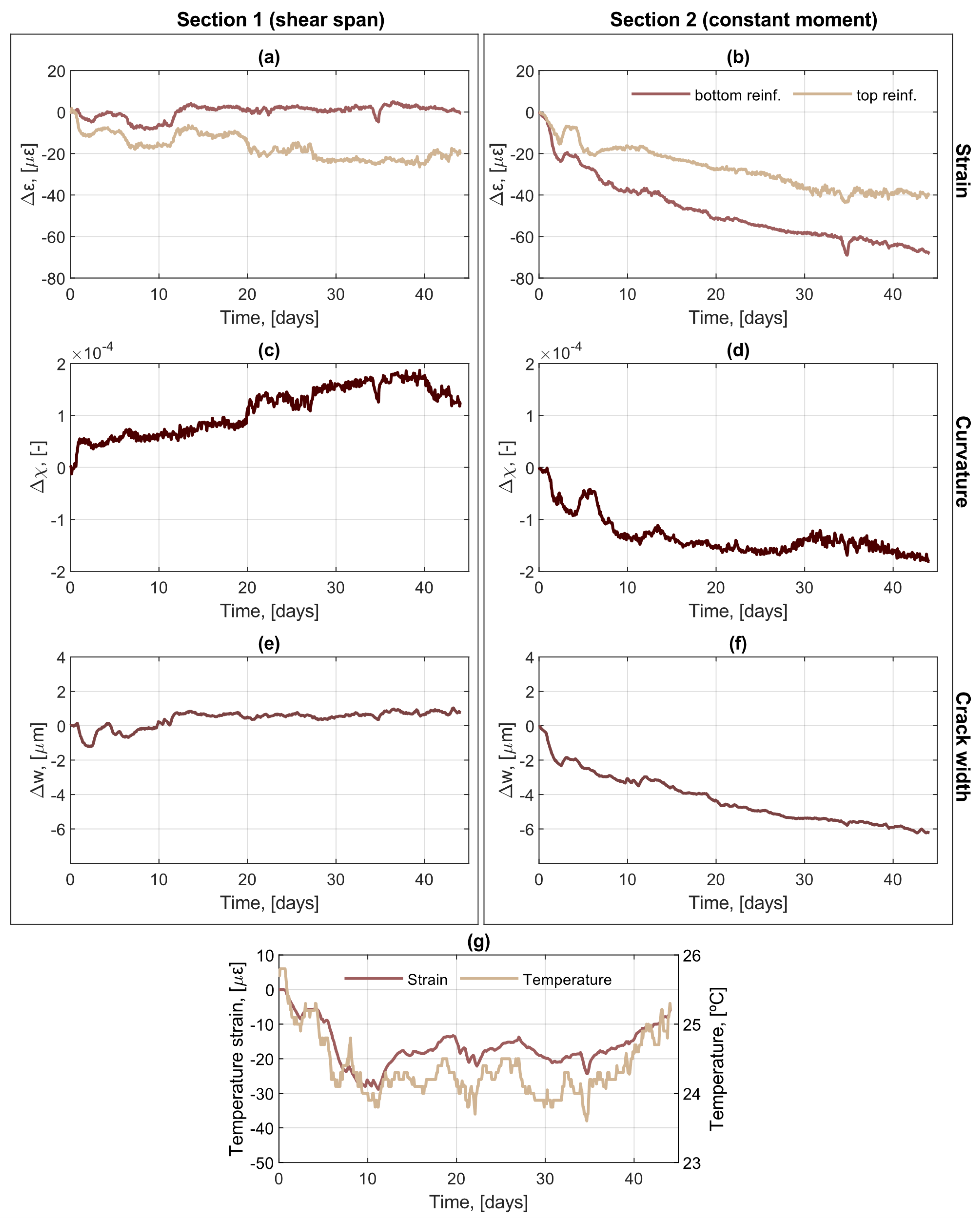
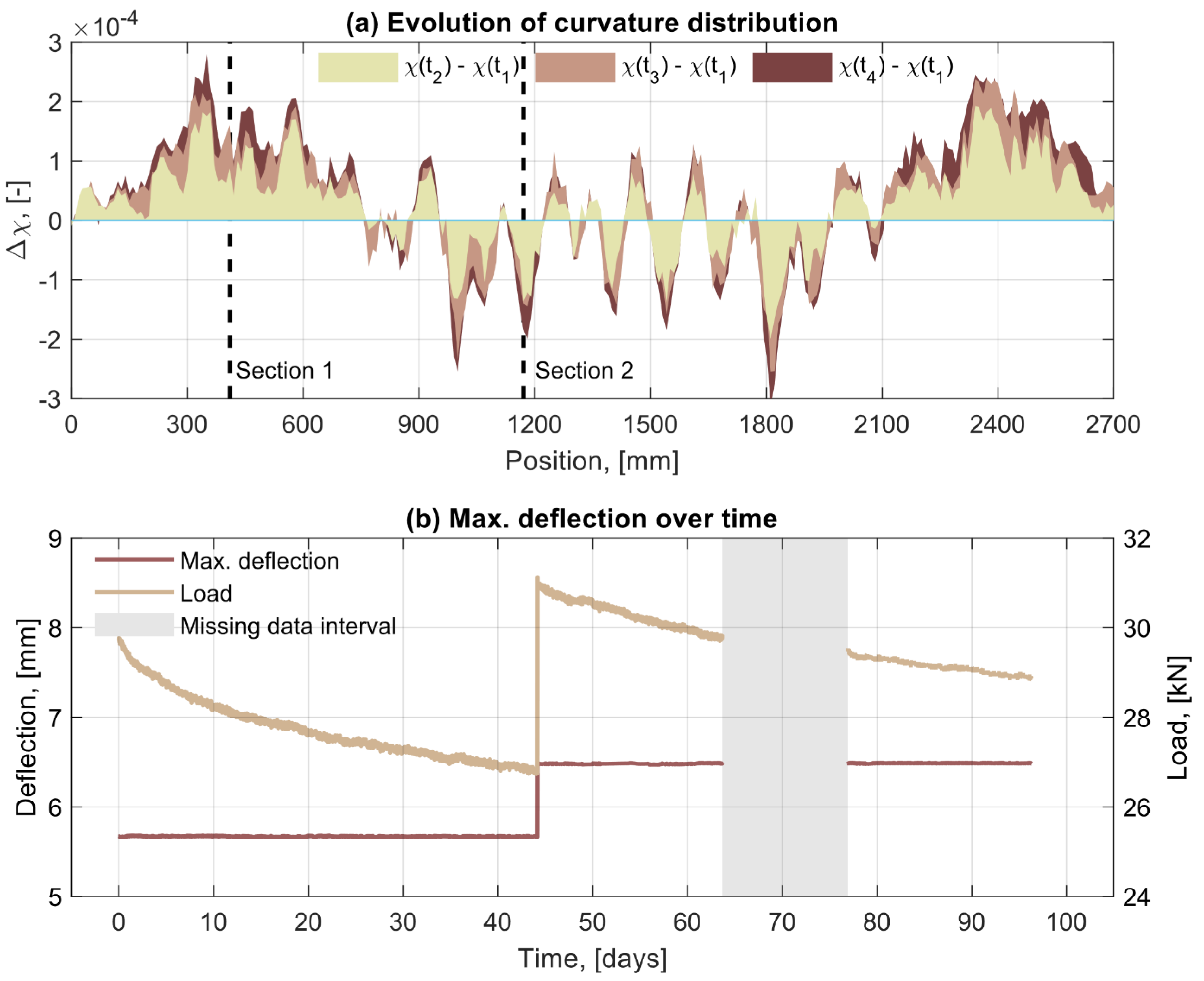
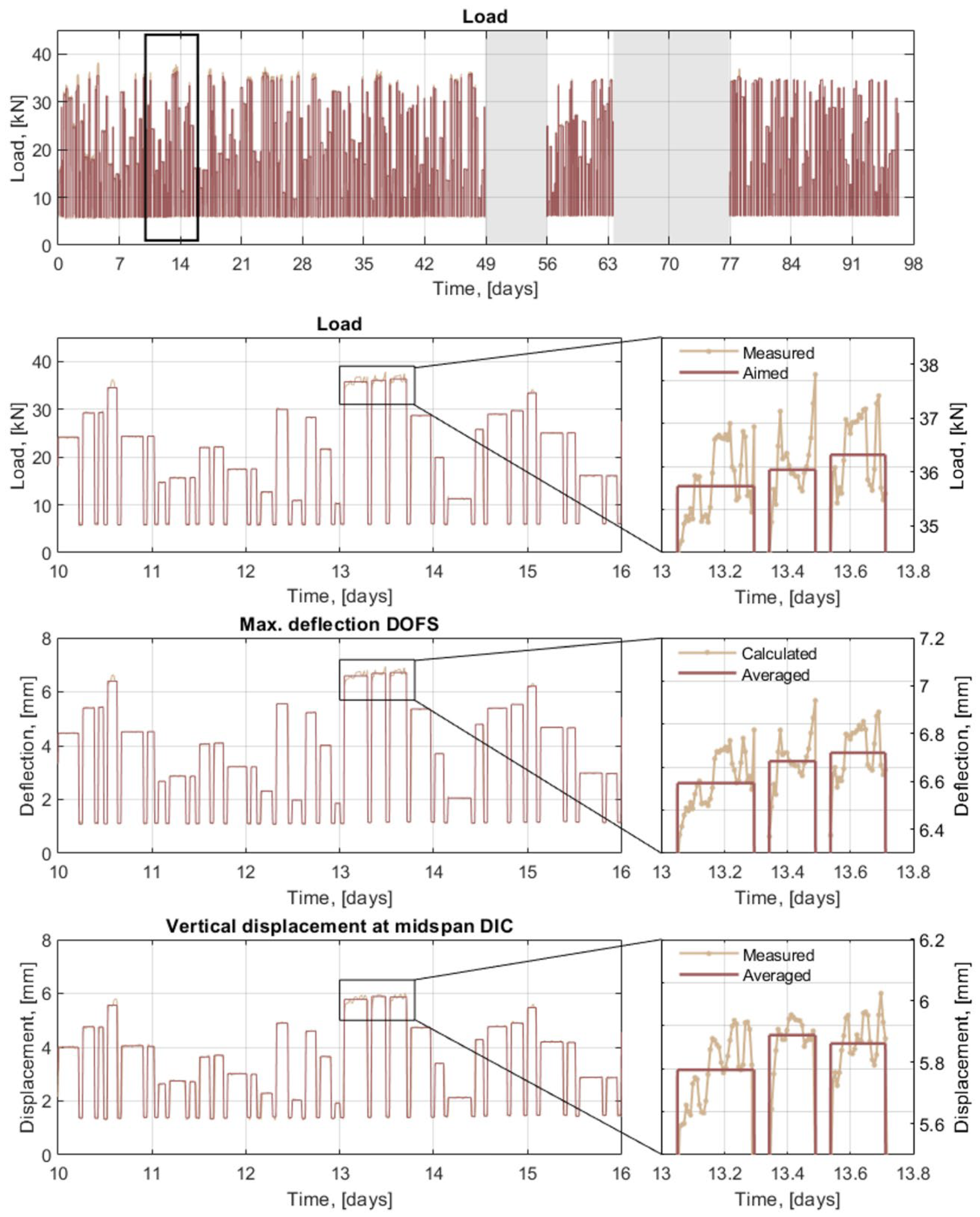
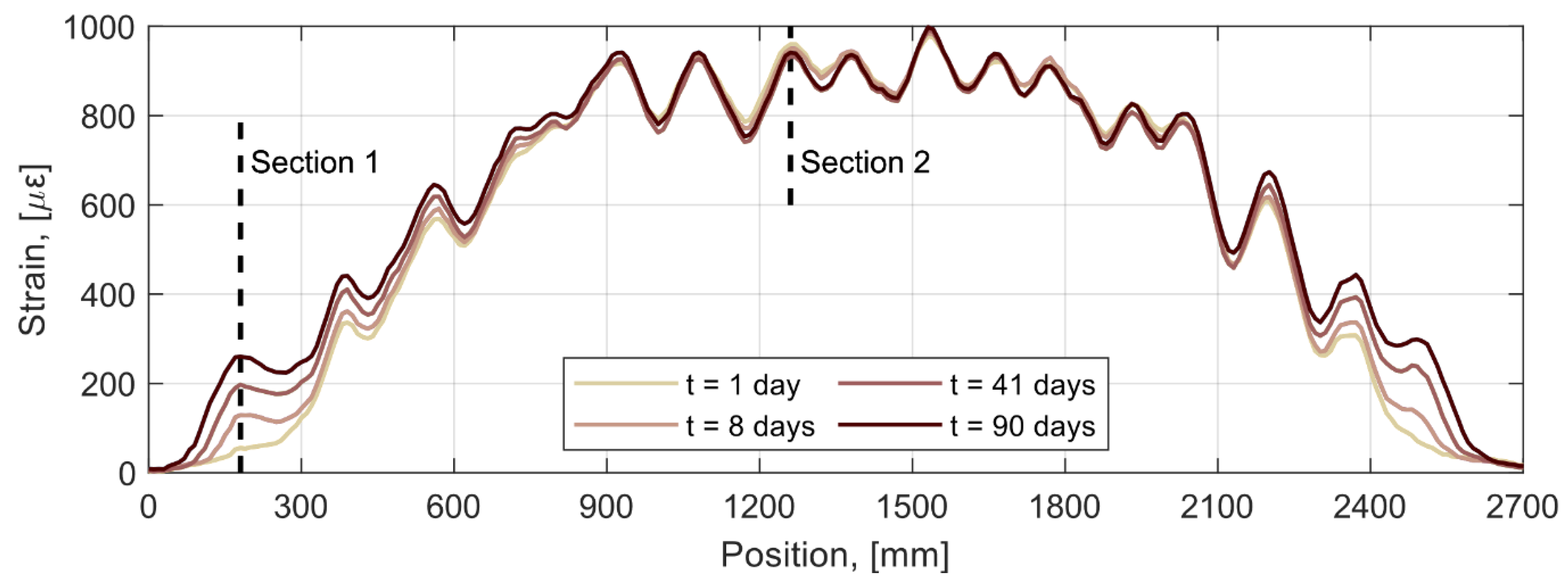
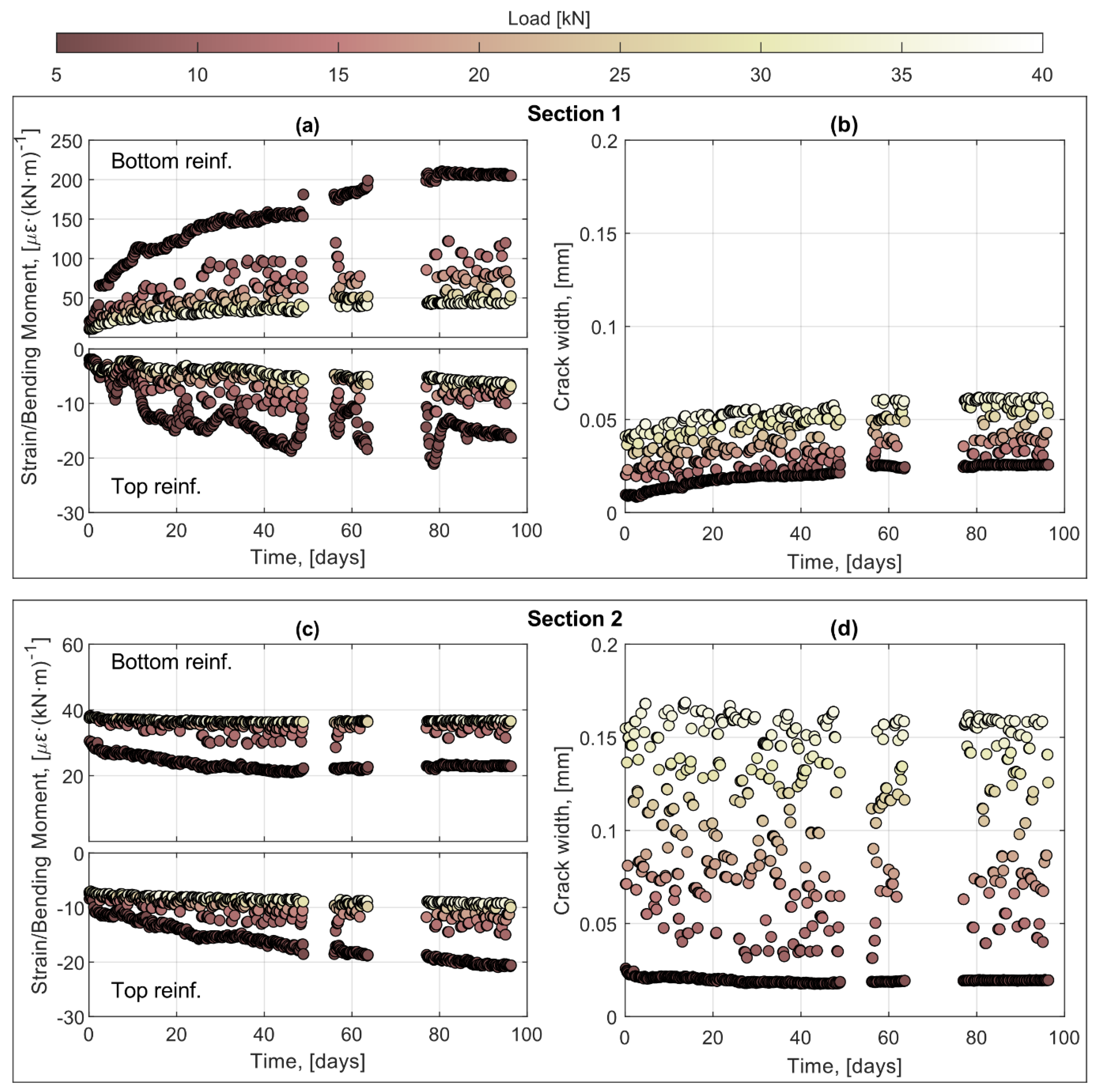
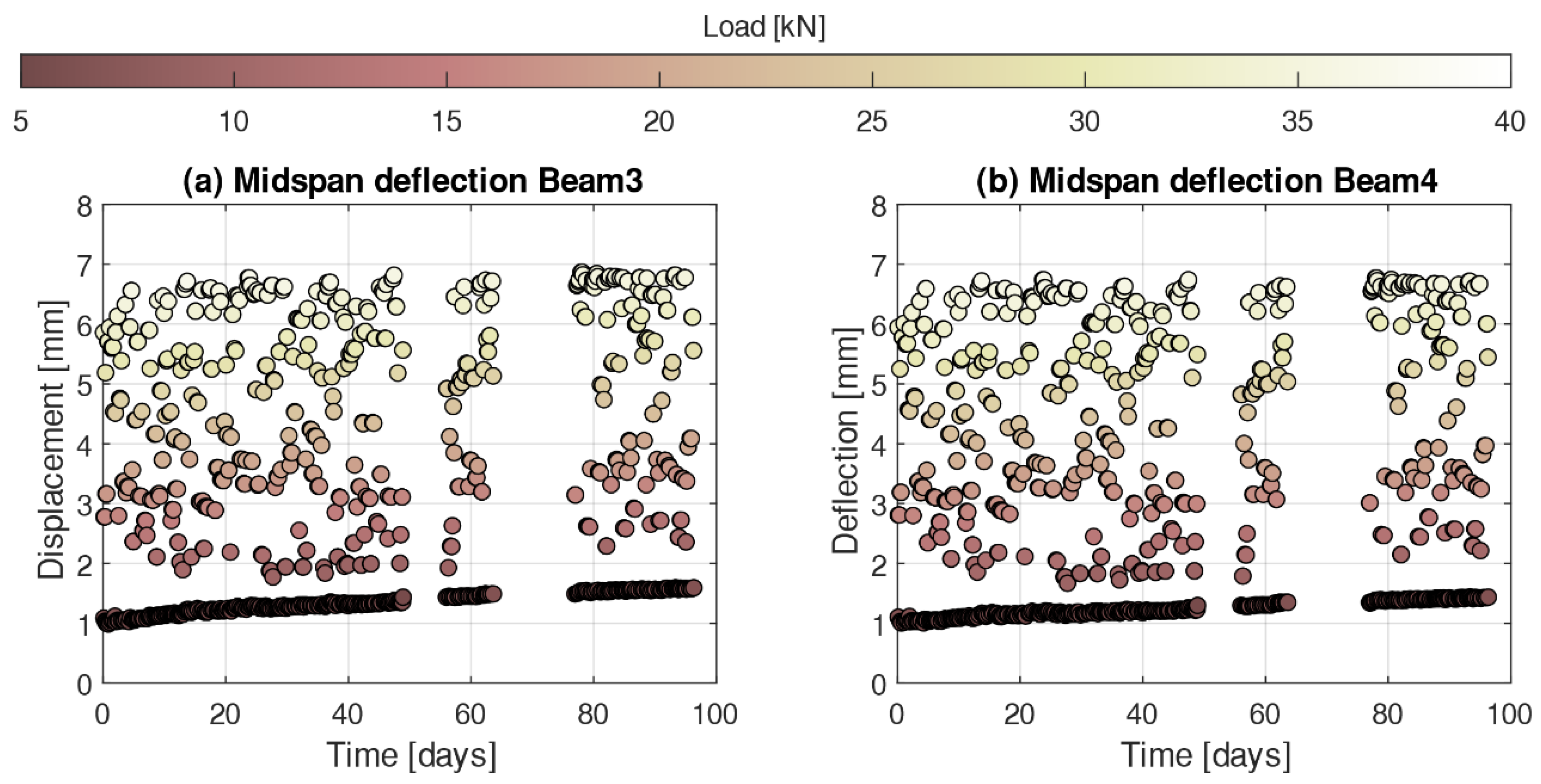
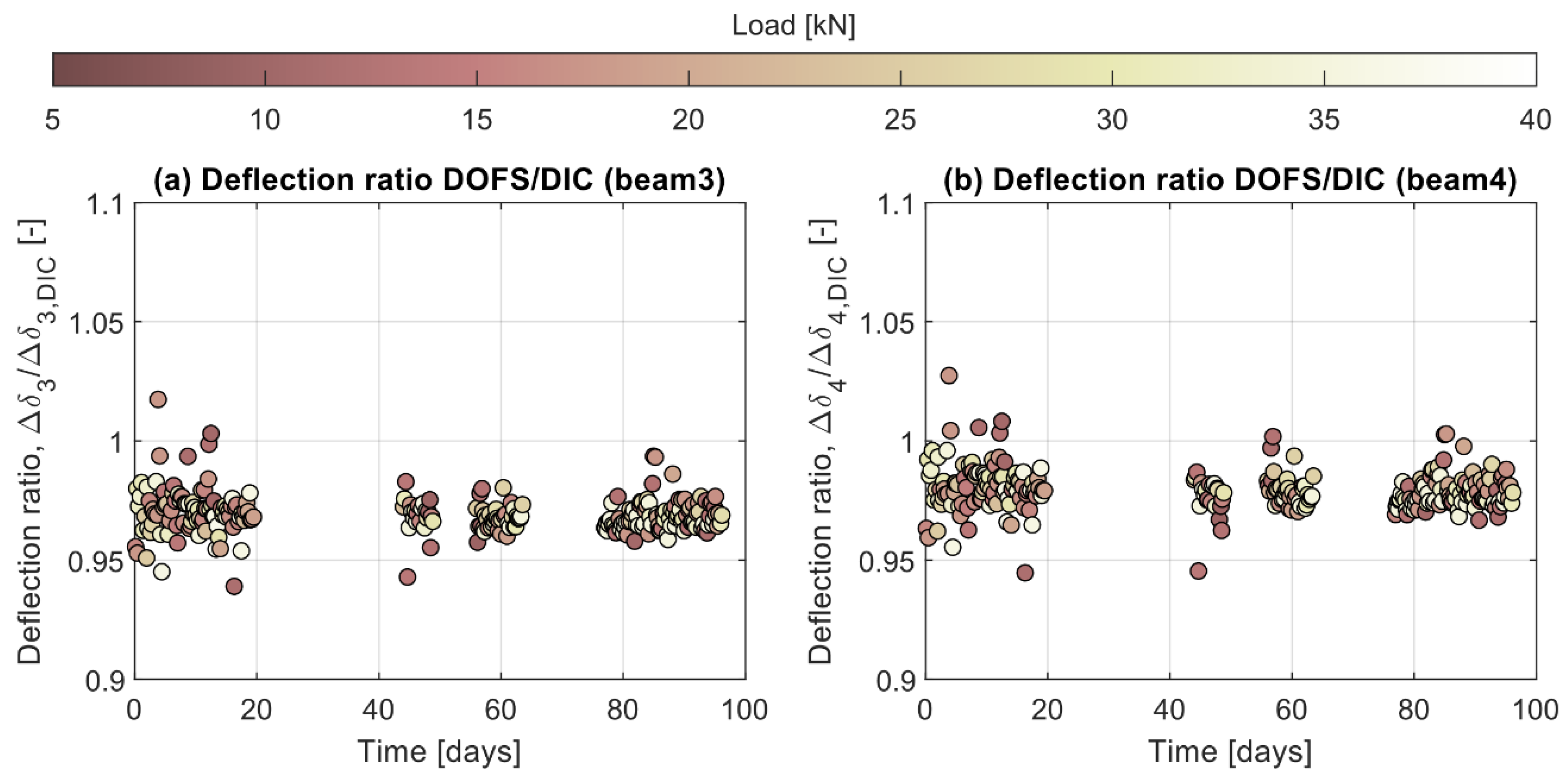
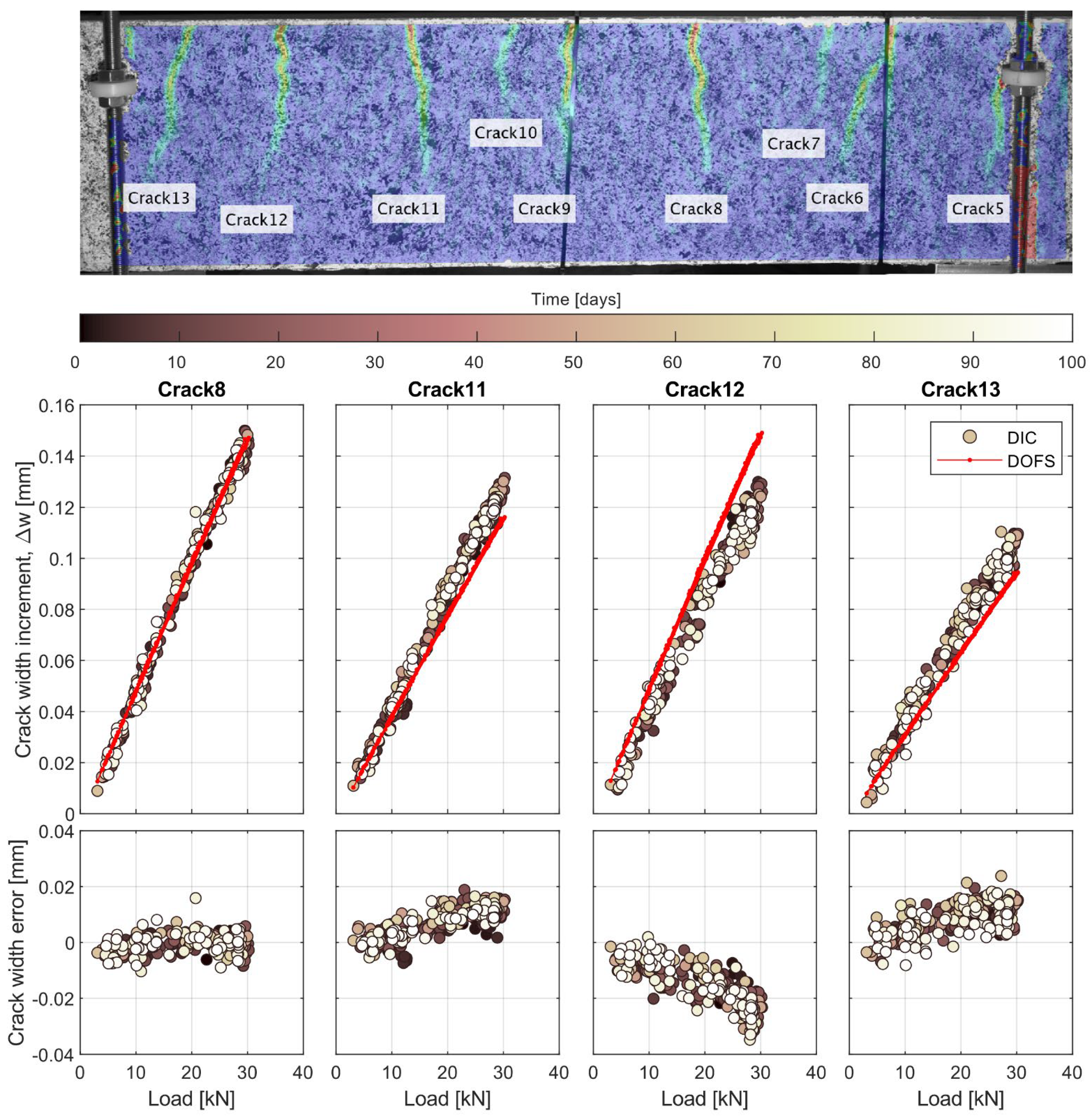
Publisher’s Note: MDPI stays neutral with regard to jurisdictional claims in published maps and institutional affiliations. |
© 2021 by the authors. Licensee MDPI, Basel, Switzerland. This article is an open access article distributed under the terms and conditions of the Creative Commons Attribution (CC BY) license (https://creativecommons.org/licenses/by/4.0/).
Share and Cite
Fernandez, I.; Berrocal, C.G.; Rempling, R. Long-Term Performance of Distributed Optical Fiber Sensors Embedded in Reinforced Concrete Beams under Sustained Deflection and Cyclic Loading. Sensors 2021, 21, 6338. https://doi.org/10.3390/s21196338
Fernandez I, Berrocal CG, Rempling R. Long-Term Performance of Distributed Optical Fiber Sensors Embedded in Reinforced Concrete Beams under Sustained Deflection and Cyclic Loading. Sensors. 2021; 21(19):6338. https://doi.org/10.3390/s21196338
Chicago/Turabian StyleFernandez, Ignasi, Carlos G. Berrocal, and Rasmus Rempling. 2021. "Long-Term Performance of Distributed Optical Fiber Sensors Embedded in Reinforced Concrete Beams under Sustained Deflection and Cyclic Loading" Sensors 21, no. 19: 6338. https://doi.org/10.3390/s21196338
APA StyleFernandez, I., Berrocal, C. G., & Rempling, R. (2021). Long-Term Performance of Distributed Optical Fiber Sensors Embedded in Reinforced Concrete Beams under Sustained Deflection and Cyclic Loading. Sensors, 21(19), 6338. https://doi.org/10.3390/s21196338





